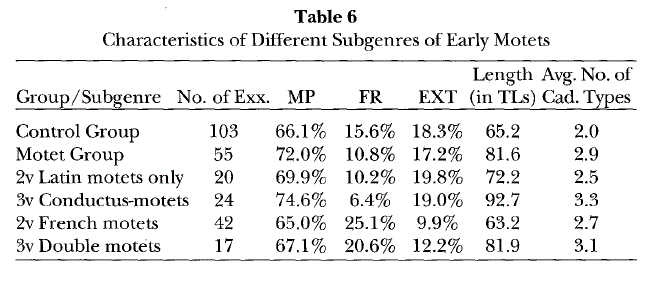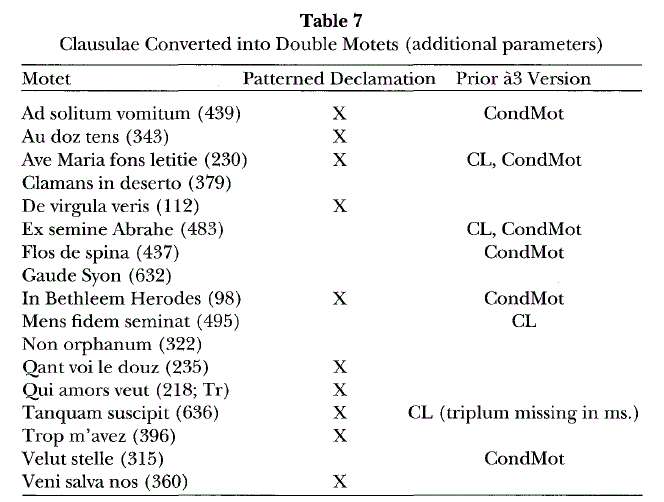| The Selection of Clausula Sources for ThirteenthCentury Motets:
Some Practical Considerations and Aesthetic Implications
3 |
| 音楽エッセイのページへ戻る | 初期多声音楽 | St.マーシャル楽派へ |
| Leoninのページへ | ノートルダム楽派(conductus)のページへ |
ペロタン(Viderunt Omnes) |
| ペロタン(Alleluja Nativitas) | ペロタン Clausulaのページ | まうかめ堂さんのページへ |
| substitute clausulaのページへ | 中世音楽のページへ | 前のページへ |
| It is now worth considering the extent to which
these selection criteria apply to other segments of the thirteenth-century
motet repertory. Table 6 provides a comparison of how the parameters
introduced thus far apply to different types of early motets. It presents
average values for the motet and control groups, and then summarizes data
gathered for different subgenres of motets. The data reported in table 6
combine statistics already reported for the motet
group-which only includes
clausulae that were converted into two-voice Latin
motets-with additional data for clausulae that were converted into other types
of motets. こうした選択基準が13世紀のモテットレパートリーの他の部門に適用される程度については、より考える価値があることだろう。Table6は、これまでに導入されたパラメータが、さまざまなタイプの初期モテットにどのように適用されているかの比較を示している。これは、モテットグループとコントロールグループへの平均値を示している。そして、モテットのさまざまなサブジャンルに対して集められたデータを集計している。このデータは、モテットの他のタイプに転換されたクラウズラに対して加えられたデータとともに、モテットグループ)2声のラテン語モテットに転換されたクラウズラのみを含む)に対してすでに報告された統計と結びつく。  TLs=ternary long units <2声ラテン語モテットへ転換されたクラウズラ> ①As indicated in table 6, twenty clausulae were converted into two-voice Latin motets but disregarded as sources for French contrafacta or as the basis for later double motets. 22 Several characteristics may have contributed to the fact that they were not chosen. ②All but three motets in this group have unpatterned or fifth-mode tenors; these slower moving tenors may have lost some of their initial appeal as composers began to experiment with faster tenors moving in first- or second-mode patterns (Baltzer 1995: xliii). ③ The three motets with faster tenor patterns might have been excluded from further transmission due to their shorter-than-average overall lengths; Virgo gignit (133) is sixty-two ternary-long beats while Hostem superat (308) and Quia concupivit vultum rex (529) have respective lengths of forty-five and twenty-eight beats. In addition, the clausulae selected as models for two-voice Latin motets have lower-than-average levels of modal purity, marked by a substantial amount of extensio modi. ④As a result, most of the uniquely two-voice Latin motets have irregularly patterned text declamation, because their texts were underlaid syllabically according to the irregular rhythms of their parent clausulae. This approach to text underlay allowed composers to emphasize selected units of text and therefore to communicate the meaning of their texts more effectively. However, while irregular declamation typifies early Latin motets, regular declamation became characteristic of other subgenres of motets. ①table6で示されている通り、20のクラウズラ群が2声ラテン語モテットへと転換されている。しかし、こうしたクラウズラ群は、フランス語contrafactaのソースとしてあるいは後の3声モテットの基礎としては無視されている。それらが選ばれなかったことには、いくつか理由があるのだろう。 ②このグループの3つのモテット以外すべては、パターン化されていないあるいは第5モードのtenorを保有している。こうしたよりゆっくりとした動きのtenorは、作曲者が第1、第2モードパターンの速い動きをするtenorを使った実験をするような初期のアピールを失ってしまうように思える(Baltzer 1995: xliii)。 ③より速いtenorのパターンを持つ三つのモテットは、平均全長より短い長さゆえに、transmissionから排除されている。Virgo gignit (133)は62のternary-longビートを持っている。Hostem superat (308) と Quia concupivit vultum rex (529)はそれぞれ45、28のビートを持っている。さらに加えて、2声のラテン語モテットのモデルとして選ばれたクラウズラは、その本質はextensio modiからなっており、モード純度においては平均より低いレベルである。 ④結果として、多くの2声のラテン語モテットは、不規則なパターンの歌詞デクラマシオンを持つことになる。なぜなら、こうした歌詞は親クラウズラの不規則なリズムに従って、シラビックに歌詞づけがなされたからである。こうした歌詞づけに対するアプローチは、作曲者をして選ばれた歌詞の単位を強調せしめる。そしてそれゆえに、歌詞の意味をより効果的に取り扱う。しかしながら、不規則なデクラマシオンがラテン語モテットを代表すれば、規則的なデクラマシオンはモテットの亜種的性格になってしまう。 ①Composers turned twenty-four clausulae into three-voice conductus-motets. 23 Many of these compositions were as short-lived as the two-voice Latin motets discussed above. In fact, less than half were transmitted beyond the earliest motet sources. ② However, clausula sources for conductus-motets have some striking differences from clausulae that were only converted into two-voice versions. The clausulae selected for conductus-motets are generally longer and have higher levels of modal purity than the two-voice motets. This makes them seem more "conductus-like" because they can support longer texts declaimed in a more consistent manner. Somewhat surprisingly, only one of the clausulae chosen to become a conductus-motet has consistently uniform phrase lengths, which could have prefigured uniform poetic line lengths.24 ③ In addition, these clausulae have a greater variety of cadence types than clausulae in any other group. This combination of conductus-like and motet-like features attests to the hybrid nature of conductus-motets, most of which were created before motet composers had solidified their preference for contrast and irregularities of design and thereby fully distinguished their new genre from the conductus. <conductus-motetへ転換されたクラウズラ> ①作曲者たちは、24のクラウズラを3声のconductus-motetに転換した。こうした作品の多くはこれまで議論された2声ラテン語モテット同様、短命なものである。事実、最初期のモテットソースを超えてtransmitされたの作品は半数以下でしかない。 ②しかしながら、conductus-motetとなったクラウズラソース群は、2声バージョンへ転換されたクラウズラ群とは決定的に異なる要素がある。conductus-motetのために選択されたクラウズラ群は、一般的に2声モテット群よりも曲の長さが長く、モード純度も高い傾向にある。こうした傾向が、より”cunductus風”を作り上げる。なぜなら、これらはより一貫したやり方で詠われたより長い歌詞を持つからである。いくぶん驚くことには、conductus-motetになるべく選ばれたクラウズラ群のうちのひとつだけが、詩行の長さが予め統一されている統一されたフレーズの長さを持っていることである。 The clausula source for Homo quam sit pura (231) has a 94.1 % reliance on four-beat phrases. ③さらに加えて、こうしたクラウズラ群はほかのそれと比べ、より変化に富んだカデンツタイプを持っている。こうしたconductus風とモテット風の組み合わせは純粋なconductus-motetの混合した性質を証明している。そうしたconductus-motetの大部分は、モテットの作曲家がデザインのコントラストと不規則性に対する選好を固定化し、それによって conductusから新しいジャンルを完全に区別する前に作られたものである。 <2声フランス語モテットへ転換されたクラウズラ> ①Clausulae selected as models for two-voice French motets also have distinctive features.25 They tend to exhibit faster tenor modes and a larger than- average share of second-mode dupla (table 6). As a group, the clausula models for French motets have moderately low levels of modal purity due to consistently high amounts of fractio modi. Since the standard procedure for texting fractured rhythms is to use neumatic text underlay corresponding to the modal rhythmic pattern, high levels of fractio modi typically result in modally regular text declamation. ②In terms of overall style, high levels of fractio modi and regular text declamation are characteristic of newly composed French motets, such as those found in W2, fascicle10, and of Latin contrafacta of French originals, such as those found in the appendix to the third Latin alphabetical series in W2, fascicle 8.26 The present study indicates that stylistic differences between early Latin and early French motets may stem in part from the "pre compositional" act of clausula selection, which was itself most likely influenced by different approaches to text underlay. ①2声のフランス語モテットのモデルとして選択されたクラウズラは、別の特徴を持っている。それらはより速いtenorモデルと平均以上の第2モードduplumのシェアを示す傾向にある (table 6)。グループとして、フランス語モテットのクラウズラモデルは、一貫して高いfractio modiの数のために、適度に低いレベルのモード純度しか持っていない。fractured rhythmに歌詞づけする標準的な過程は、モードリズムパターンに相当するネウマ譜の歌詞化を利用することであるので、高いレベルのfractio modiは通常、モード的に、規則的な歌詞のデクラマシオンをもたらすことになる。 ②全体的なスタイルでいえば、fractio modiの高いレベルと規則的な歌詞のデクラマシオンは新しく作られたフランス語モテットの特徴である。こうした例はW2写本の第10冊子に見られ、そしてフランス語オリジナルのラテン語contrafactaのうちで、これはW2写本における第8冊子、第3ラテン語アルファベット順シリーズへのappendixに見つけられる。現在の研究は、初期ラテン語モテットと初期フランス語モテットの間の様式の相違が、部分的には歌詞付けに対する異なったアプローチによって大きく影響されたクラウズラの選択における”曲が作られる前の”行動から始まっている可能性を示している。 ①As shown in table 6, only seventeen clausulae were transformed into later thirteenth-century double motets, with independent texts for the motetus and triplum voices.27 What factors led composers to use these clausulae as the basis for sophisticated double motets while ignoring countless other potential models? ②Their overall lengths and number of different cadence types are close to those for the motet group as a whole. However, since many of these clausulae were converted into two-voice French motets as well as three-voice double motets, they have a higher incidence of second-mode dupla, higher levels of fractio modi, and lower amounts of extensio than the motet group overall. These features, combined with the presence of three clausulae in relatively pure third mode, result in fairly regular or "patterned" text declamation. In fact, as summarized in table 7, ten of seventeen clausula-based double motets feature patterned text declamation in at least the motetus voice. <3声モテットへのクラウズラの転換> ①table6で示されたように、17のクラウズラのみが、motetusと triplumが独立した歌詞を持つことで、13世紀後半の3声モテットへ転換された。どのような要素が、作曲者たちをして、無数の他の潜在的なモデルを無視しながら、洗練された3声モテットのベースとしてこうしたクラウズラを使わせしめたのであろうか? ②異なるカデンツタイプのこれらのあらゆる長さと数は、概して、モテットグループに近い。しかしながら、多くのこのようなクラウズラは3声のモテット同様、2声のフランス語モテットに転換されたために、それらはモテットグループ全般よりもより高い第2モードのduplum、より高いfractio modiのレベル、より低いレベルのおびただしいextensioの発生を惹起している。こうした特徴は、比較的純粋な第3モードを持つ3つのクラウズラの存在と組み合わされて、規則的な、あるいはパターン化した歌詞のデクラマシオンの結果となっている。事実、table7でまとめられているように、クラウズラをベースとした17の3声モテットのうちの10ケは、少なくともmotetusにおいては、パターン化した歌詞のデクラマシオンの特徴を示している。 ①Undoubtedly the clausulae listed in table 7 possess additional features that composers found appealing and worth preserving into the later thirteenth century. Many of them seem exceptionally tuneful, in part because of the presence of melodic repetition. Others may have enjoyed continued popularity on the basis of their texts. However, one additional factor seems striking: As indicated by table 7, eight of the seventeen clausulae that were transformed into double motets had three-voice clausula sources and/ or prior conductus-motet versions. ②The texting of a prior three-voice model was an uncommon procedure. More typically, composers created a three-voice motet by adding a newly composed triplum to a preexisting two-voice foundation. Furthermore, many of the motets generated by adding new text to a three-voice model are exceptional in terms of style as well as in terms of compositional process. ③For instance, later composers converted Ave Maria fons letitie (230) and Ex semine Abrahe (483) into double motets by adding text to the tripla of their earlier conductus-motet versions. As a result, both motets feature parallel phrasing between their motetus and triplum voices, a fairly homogenous rhythmic style, and for the most part, simultaneous text declamation. This contrasts with the more typical style associated with double motets: overlapped phrasing, rhythmic contrast, and more distinctive text declamation. ①疑いなく、table7で示されたクラウズラ群は、作曲者がアピールし、そして13世紀後半にその価値を有していた付加的な特徴を持っている。これらの多くは、部分的にはメロディの繰り返しの存在のために、例外的にメロディ豊かである。その他のものはこうした歌詞をベースとして持続的な人気を誇っている。しかしながら、付加的な要素も注目すべきことである。table7で示されたように、3声モテットへと転換された17のクラウズラのうちの8つは、3声クラウズラかあるいはもともとconductus-motet(3声)バージョンであったものである。 ②もともとの3声モデルへの歌詞づけは、通常ではない過程で進んだ。通常は、作曲者たちはもともと存在していた2声の基礎に対して、あらたに作ったtriplumを加えることにより、3声モテットを作曲していったのである。それゆえに、3声モデルに対して新しい歌詞がつけられたモテットの多くは、作曲過程の面と同様、様式面においても異例といえる。 ③たとえば、後の作曲者は初期の conductus-motet バージョンのtriplumに対して(新たな)歌詞を付加することによって、Ave Maria fans letitie (230)と Ex semine Abrahe (483)を、3声モテットにconvertした。その結果、両方のモテットは、motetusと triplumの間の並行的なフレーズ、均一なリズム様式、そして大部分における歌詞の同時的declamationといった(conductus-motet的な)特徴を持つようになった。これは、重複したフレーズ、リズムの対照性、そしてより独特な歌詞のdeclamationといった、より典型的な3声モテットに関連する様式とは対照的である。  Mens fidem seminat (495) illustrates a somewhat different situation. After its early history as a two-voice Latin motet, composers turned Mens fidem into three-voice bilingual and French motets by simply adding text to the triplum voice of its preexisting three-voice clausula source. While the sources for Ave Maria and Ex semine were adapted into conductus-motets because they have parallel phrasing in the upper voices, the In odorem (M 45) source for Mens fidem has overlapped phrasing between the upper voices and would not have been suitable for conversion into a conductus‐motet. The three-voice textings of this clausula are therefore closer to the expected style of a double motet because they feature contrasts in phrasing and declamation. Mens fidem seminat (495)はいくぶん異なった状況となっている。当初、2声のラテン語モテットとして存在した後、 作曲者はもともと存在していた3声のクラウズラソースのtriplum部分(magnus liber2 p88?)に歌詞を単純に付け加えることによって、3声のラテン語‐フランス語モテットMens fidem を作成した。Ave Maria と Ex semineのソースがconductus-motet群であったのは、それら(conductus-motet)が上声部において並行するフレーズを持っていたためであるが、Mens fidemのソースとしてのIn odoremは上声部間でフレーズを重複させていたために、conductus‐motetへの転換には適当ではなかったのであろう。このクラウズラの3声の歌詞づけは、フレージングとdeclamationにおいて、対照的な特徴があるがゆえに3声モテットとして期待されていた様式により近づいていることになる。 The composers of at least four motets with preexisting three-voice versions replaced the extant tripla with new ones: In Bethleem Herodes (98), Velut stelle (315), Flos de spina rumpitur (437), and Ad solitum vomitum (439).28 While the triplum to Ad solitum vomitum generally moves with the motetus in note-against-note counterpoint,29 the other three motets exhibit significant degrees of musical independence between the upper voices. もともと存在していた3声バージョンを持つ少なくとも4つのモテットの作曲者は、既存のtriplumを新しいものに置き換えた。In Bethleem Herodes (98), Velut stelle (315), Flos de spina rumpitur (437), and Ad solitum vomitum (439)である28。Ad solitum vomitum のtriplumがnote-against-note counterpointにおいてmotetusへ移った場合でも29、他の3つのモテットは上声部間においてかなりの程度の音楽的独立性を示す。 28. It is impossible to comment on the conversion of a three-voice Tanquam clausula into the motet Tanquam suscipit (636) because the triplum to the clausula source was never entered into the Florence manuscript (Dittmer 1959: fol. IOv 訳注;写本ではtriplum部分が抜けている). 29. Baltzer (1974: 140-41) has pointed out that the use of note-against-note counterpoint is typical of third-mode clausulae. ①The fact that clausula sources used as the basis for later thirteenthcentury motets differ from those chosen for the earliest motets underscores the significance of clausula selection. By texting clausulae with irregular modal rhythms and variable numbers of phrases and cadential patterns, composers of the earliest Latin motets defined their new genre as something different from the clausula and the conductus. Composers seem to have been attracted to a different type of piece when creating double motets; in general, they seem to have preferred clausula-based motets with more regular rhythmic patterning and/or text declamation in the motetus voice. While double motets feature greater regularity within individual voices, these individual voices combine in highly sophisticated ways due to the independent nature of their texts, rhythmic profiles, phrasing, and cadential points. ②The resulting combination of voices often sounds "irregular" due to its polyphonic, poly textual complexity. In effect, the composers of later thirteenth-century double motets transferred an established preference for irregularity and contrast from the horizontal dimension (within the motetus voice) to the vertical dimension (between motetus and triplum voices). Thus reinterpreted, the aesthetic foundation established by composers of the earliest Latin motets continued to shape the subsequent development of the genre. ①13世紀後半のモテットのベースとして使われたクラウズラのソースが最初期モテットのために選ばれたそれと異なるという事実は、クラウズラ選択の重要性を強調する。不規則なモードリズムや、フレーズやカデンツパターンの可変性とともに存在するクラウズラによって、最初期のラテン語モテットの作曲者たちは彼らの新しい創作分野をクラウズラやconductusとは異なるものと定義した。作曲者たちは、2声モテットを作る時には、異なったタイプの作品に惹きつけられていた。一般的に言えば、作曲者たちはmotetus 中における、より規則的なリズムパターンや歌詞declamationを持つクラウズラをベースとしたモテットを好むようになったように見えた。3声モテットが個々の声部におけるより大きな規則性を特徴としながらも、個々の声部は、歌詞やリズム描写やフレージング、カデンツ点の独立した性質ゆえに高く洗練されたやり方で組み合わされている。 ②結果として組み合わされた声部は、その多声、多歌詞性ゆえに、しばしば”不規則に響く。実際、13世紀後半の3声モテットの作曲者は、不規則性と対照性に対して向けられていた趣向を、水平次元(motetus内)から垂直次元(motetus・triplum間)へと移した。こうして再解釈された最初期のラテン語モテットの作曲家によって確立された審美的な基盤は、その後のジャンルの発展を形作ったのである。 |